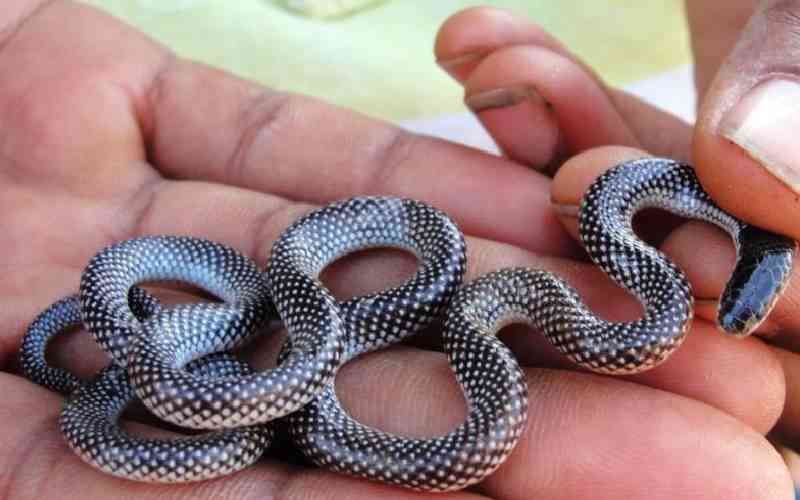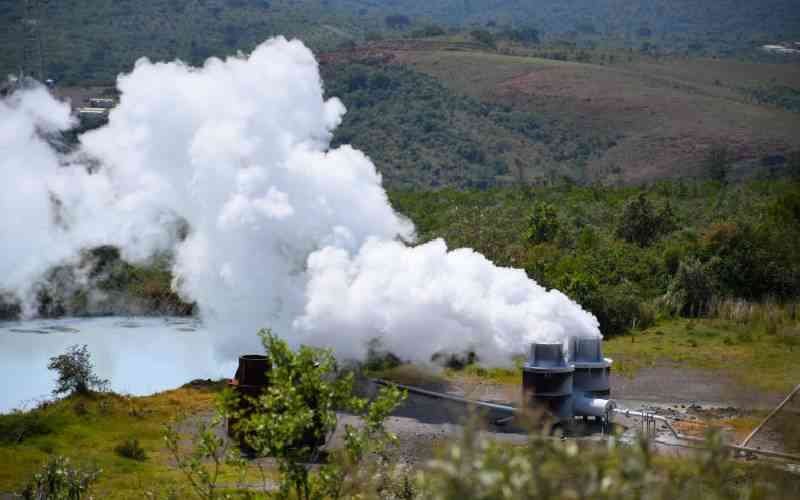
In the vast four hectares of land across the rolling landscapes of Kwamiui village in Makueni county, Benedetta Kyengo’s farm is recognised for its syntropic farming practices.
In addition to the lush green vegetation, a special portion is reserved for the conservation of biodiversity among wild animals.
Kyengo, who has been practicing natural farming since 2020, believes in mimicking natural processes to allow survival of animals, including feared reptiles like snakes.
“With agro-ecology that is nature-based, we focus on everything; that’s why we allow nature to take its course. We don’t kill snakes, they are part of the natural environment,” he says.
Snakes are some of the living creatures that elicit fear and negative machinations among communities and individuals. In Kenya, the sighting of a snake is often met with a concerted scram, which is followed by concerted efforts to kill it.
In Western countries, snakes are kept and well cared for. One story recounts a white expatriate who once showed up at the office with her defanged Albany Adder happily coiled around her neck. The office emptied in seconds!
Different from the African context, snakes are perceived to bring bad luck and are always unwelcome in human surroundings.
The religious ones also have mixed perceptions of the creature. Christians and Judaists, view it as a symbol of evil and also of spirituality and intelligence.
But for Kyengo, a snake is as harmless as any other animal and, in her view, should exist for a purpose. “They are part of the ecosystem’s balance. At the farm, they can feed on the moles and the moles feed on the mites and the mutual benefit is concurrent,” she says.
She has allowed snakes to exist to support the food web and conserve biodiversity adding that serpents are predators that mostly feed on rodents on the farm hence helping in pest management.
Although she works on the farm daily, she has not had any frightening encounters with the snakes; she simply watches them slither from a distance.
“The snakes are there, especially the small ones; they have never caused any harm to the workers,” she says.
She doesn’t allow the use of pesticides on her farm, and, according to her, this allows affected leaves to fall on the ground to enhance soil nutrients and water retention.
Stay informed. Subscribe to our newsletter
“We let nature take its course. By doing that, we attract natural predators that help in restoring the natural food web,” she adds.
Kyengo’s farm initially relied on the Kwamuiu dam which is 700 meters away for water.She has explored the use of solar energy to drill boreholes and sink 14 water pans to harvest rainwater.
The 70-meter-deep borehole holds about 20 cubic meters of water when fully recharged, enabling an adequate supply of water to the farm. “This has been a relief even for the wild animals to drink from the trenches dug along the farm,” she says.
Desert-like snakes are known to use special adaptation tactics to survive in extreme water shortage environments. For instance, they have dorsal scales with micro-nano structures to pin the impacting water droplets during cold winters.
The prolonged drought can affect the snake population but the creatures can use a reproductive strategy referred to as “income breeding” to fuel reproduction after the drought.
Fossorial snakes hibernate deep underground during droughts and feed largely on earthworms, which exist even during a drought, as the ground retains moisture. The fossorial snakes after hibernation can also serve as the base of the snake food chain since they are often preyed upon by larger snakes.
Ecologist Eric Ngure reveals that apart from the creatures’ unique characteristics, they help people living in earthquake-prone areas to foresee natural occurrences.
“When there are tectonic movements on the ground, the snakes, by their nature, detect the roughness. People living in earthquake-prone areas will see the snakes migrate before it happens,” says Ngure.
However, he notes that the ophidians often suffer whenever bushfires happen, since they can only detect occurrences that happen underground.
The scientist concurs with Kyengo that the slithery reptiles play a very critical role in the balancing of the ecosystem by regulating the population of small mammals, reptiles, and birds.
Snakes and lizards are of the same family and share some characteristics like being carnivores and coldblooded, hence relying on the sun to regulate body temperatures.
Snakes are majorly divided into two categories depending on how they capture their prey; old world and the new world snakes.
Old-world snakes are characterized by large and highly masculine body structures like the anaconda, and python, while the lighter ones include mole snakes. The new world ones, evolved from the old world snakes.
The New world snakes are further divided into two groups namely Mambas and vipers. Mambas have smooth skins and can slither quite fast within their habitats while vipers are sluggish, short, and rough-skinned.
According to a report by the Society for Conservation Biology, snakes in Africa are facing an alarming extinction. The report released in December 2023 revealed that the snakes were vulnerable to the increasing human population, noting that 20,000 are killed annually.
“The predicted doubling of Africa’s population by 2050 is likely to pose a disproportionate threat to snakes compared to other taxa.” (Taxa are groups of organisms as organized by taxonomists based on shared characteristics).
Types of snakes
It is also feared that by 2050, on average, 71 per cent of snake ranges of conservation concern will overlap with areas occupied by ten or more people per km2, a 22per cent increase from 2020,” read the report.
Ngure, however, notes that the New World snake population has kept increasing because of the availability of prey.
On the other hand, the old-world snake population faces distinction following the effects of climate change impacts like habitat loss, and ecosystem disturbance.
Although there are a variety of snakes in the world, the ones in Kenya are specific types that scientists encounter from time to time.
Rock pythons are long with dark colourful coats and are usually found in marshy places. They exclusively feed on medium and large-sized mammals.
Black mambas, which are also the fastest in the world, are olive, brown, and grey snakes that slither quite fast.
Their name is derived from their black mouth which are visible especially when they are agitated and about to attack.
They bear more neurotoxic venom which easily immobilises prey within minutes to cause cardiac arrest.
Puff adders, which are pit vipers, are short and stumpy snakes known to puff when they are in danger or about to attack a non-food organism like humans.
The puff adders have more cytotoxic venom which causes necrosis (death of cells and tissues in the site of bite).
The adders account for the highest number of bites and subsequent deaths in Kenya and Africa. Attacks on humans stem from their tendency to be found along footpaths where they waylay their prey under camouflage. These snakes are also not bent to leave the space as the path users approach, hence creating a likelihood of being stepped on and attracting their ire.
Green Mambas are green-yellow tree-dwelling snakes that rarely interact with humans.
They also have cytotoxic venoms just like the black mambas.
Red spitting cobras are red-brownish-coated snakes that have a typical zebra pose. They are also known to bite with neurotoxic venom, and are able to spit often. Other common snakes found in Kenya are egg eaters, brown house snakes, rhombic vipers, grass snakes, and the boom slang.
Ngure explains that snakes attack humans because it’s the only mode of defense that they know of. He refers this to the foraging theory.
“Ambush hunting snakes take larger meal sizes which can take longer before it is fully digested, the active foraging feeds on smaller preys.”
Ngure points out a unique feature of snakes using constriction on prey. He says they can vomit out their catch whenever they sense danger.
“When it has taken a meal that is yet to be digested but perceives danger or stress, it vomits to remain lighter so that it can escape,” he adds.
Though very dangerous, there are animals that hunt the venomous serpents like the Mongoose, red-tailed hawk, owls, crocodiles, hedgehogs and honey badgers.
But one interesting characteristics of snakes is their ability to prey on each other to beat hunger and reduce their population. For instance, the big snakes can eat others if the prey is scarce and they are starving.
But, according to Ngure, some eat others for weird reasons.
Anaconda, after mating, the female may eat its male counterpart and other smaller males around it to have the protein it needs for the offspring. These huge serpents may also engage in cannibalism outside the mating season as a way of eliminating competition.
Dr Mitchel Okumu, a forensic pharmacist and toxicologist at Jaramogi Oginga Odinga Teaching and Referral Hospital, notes that large snakes (constrictors) use one method of killing prey, which is suffocation. But smaller snakes bite.
Okumu implores that the non-constrictors often apply dry bites in defense since they only use the venom on their prey. Hence, snake bites are mostly accidental, especially on humans.
“If it spends too much venom on biting humans, it will take a lot of time to create another. The snake might stay hungry for a longer time,” says Okumu.
Before an inflicted bite, it gives warning signs which vary from high-pitched hisses, and at times dry bites.
When bitten
Okumu advises that once one is bitten, they should stay calm to avoid increasing blood flow. One is also advised to take note of the characteristics of the snake that inflicted the bite to help in subsequent treatment procedures.
The toxicologist then breaks down the procedure of treating snake bites.
He says he first looks for local and systemic symptoms such as swelling, inflammation, edema, flaccid paralysis, respiratory distress, and abnormalities in clothing, among others.
People are usually accustomed to the idea of administering first aid like tying tightly the affected area to avoid venom circulation. He warns against such measures.
“Tying clothes as a first aid measure can trap the venom in a specific compartment, and when you reach the hospital, its release can be harmful. This can damage tissue, potentially leading to amputation, or cause a dangerous build-up of pressure, requiring the patient to undergo a fasciotomy,” he explains.,” he elaborates.
He notes that treatment depends on the kind of snake, its venom and amount.
Focusing on two species of venomous snakes, medics study the neurotoxic, predominantly psychotoxic, and haemotoxic characteristics of these deadly snakes.
Okumu says that the cost of treatment is quite expensive as a barrel of antivenom costs between Sh400 and Sh600.
Anti-venom and tetanus injections are normally administered together with care of the wound. Healing can take a few days or weeks depending on the kind of snake and the prolonged effect of the venom.
The medic says in instances of complications, the patient is kept for a while to monitor the effectiveness of the medication.
“Haemotoxic components can disrupt the blood clotting process. The blood might also form a lot of clots circulating in different parts of the body causing heart attack or stroke,” he emphasises.
The toxicologist says most of the bites in the country are common in Baringo, Kilifi and Kitui counties, with Kisumu and other counties recording low numbers.
Delving into why some humans eat snakes, he opines that the venom might not have a negative effect since it’s a protein, hence, non-venomous snakes are the ones that often end up on the menus.
Another unsettling behaviour of snakes is their ability to self-destruct. Cases of the reptiles turning on themselves, although rare, is attributed to hunger, disease or distress. This often occurs to snakes under captivity. Pythons also inadvertently sink their curved fangs into their bodies, in cases of missed attacks on prey. Whenever this happens, the constrictors may struggle to extricate themselves from their own fangs, leading to injuries and death.







